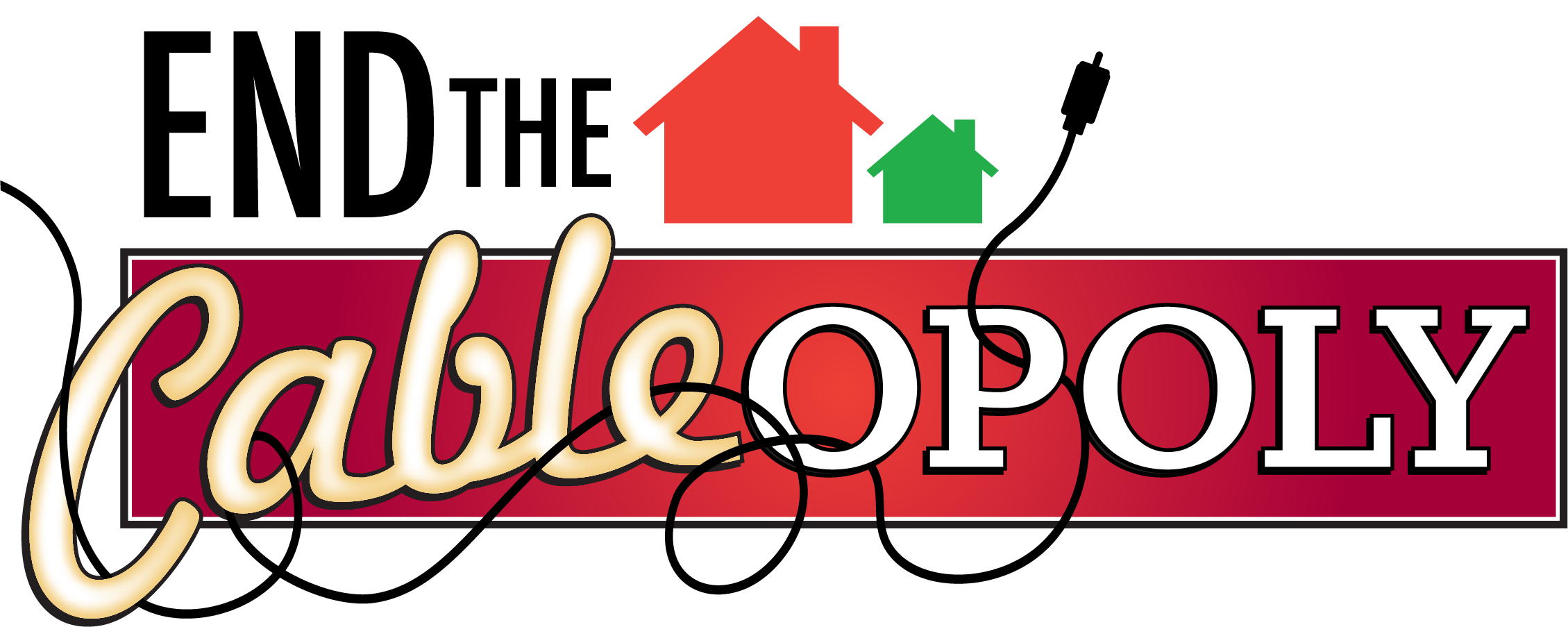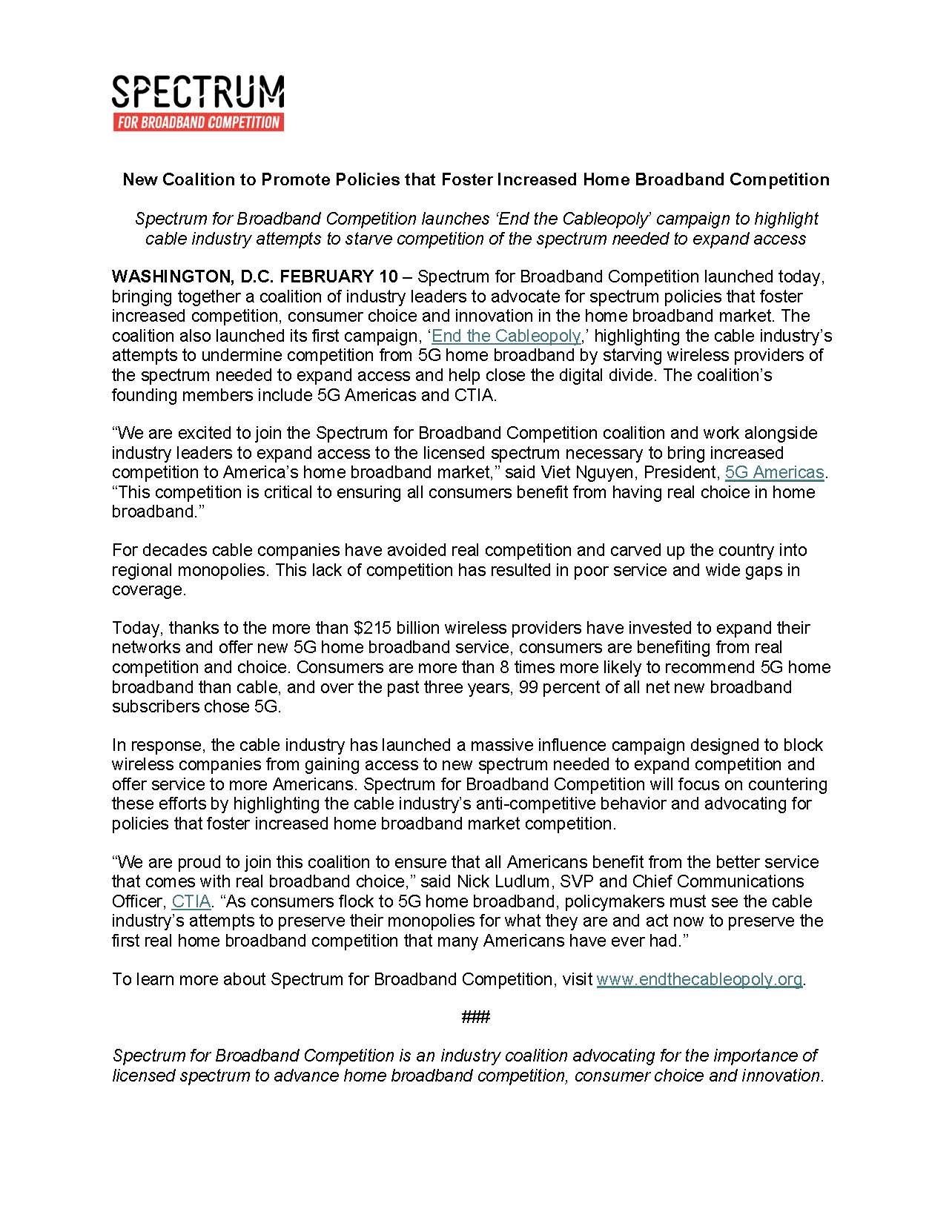
Statements and Press Releases
How The Cableopoly Harms Consumers

A Hunt for Cable’s CBRS Deployments Turns Up… Not Much
02/2025, Read More
US cable companies Comcast and Charter Communications have long suggested that they will build their own small-scale public wireless networks using their 3.5GHz CBRS spectrum holdings. Doing so, according to the companies, will help them reduce their MVNO payments to Verizon.
But so far there are few signs they’re actually doing that.
'Trouble All the Time.' Hyannis Businesses Challenge Internet Speeds Promised by Comcast
![]()
07/2024, Read More
Cape Cod has a connectivity crisis, and internet users are underserved by Comcast, the primary internet provider on the Cape. The crisis is brought on by lack of competition with internet service providers, lack of infrastructure investment by Comcast and a need for better speed test reporting from users. “We have trouble all the time with our internet,” local shop owner Amanda Converse said. “We’re consistently kicked off our Wi-Fi when trying to run transactions. Sometimes it’s questionable if we can run credit cards. I’m consistently dropped from Zoom calls.”
Comcast has the highest prices and poorest service documented by the Massachusetts Broadband Institute.
Comcast’s And Charter’s Broadband Monopoly Continues To Grow
![]()
04/2022, Read More
These two cable giants’ [Comcast’s and Charter’s] market share continues to grow not really because they’re good— but because they’re the only option countless Americans have if they want modern-era broadband speeds.
As Comcast dominates a market, it exploits the lack of competition not only to routinely raise rates (even during a pandemic, as it turns out) but to also impose all manner of arbitrary usage restrictions and obnoxious, unnecessary fees, allowing it to drive up the advertised price even further. In a bid to justify market failure, monopolization, and the corruption and regulatory capture that protects it, policymakers will often point to some looming technological innovation just over the horizon that will make all of this better without intervention.
Comcast’s Nine-Hour Outage Cripples Haverhill’s Largest Business Park
![]()
02/2022, Read More
A lengthy and widespread internet outage in Haverhill, Mass. brought down WHAV and shuttered offices throughout the Ward Hill Business Park, the city’s largest economic engine. The nine-hour outage disconnected businesses from customers and even their own corporate offices. Haverhill City Councilor John A. Michitson, who has long advocated attracting another broadband provider to Haverhill, frequently argues Comcast’s monopoly puts the city at a disadvantage.
Spectrum monopoly on cable, internet service in Cleveland needs to end (LTE)
![]()
08/2022, Read More
If our new mayor, Justin Bibb, really wants to bridge the digital divide in Cleveland, then he needs to stop the plague on the city…that would be the monopoly that Time Warner, now Spectrum cable, has on Cleveland. Currently, I pay over $200 dollars a month for the lowest cable and internet service that spectrum offers. That is outrageous. Some healthy competition would help lower the costs of these services for people who are on a fixed income, like me.
One Fascinating Reason Cable Companies Won’t Willingly Compete Against Each Other
![]()
05/2016, Read More
If you’re like many Americans, you might live in an area that’s effectively dominated by a cable monopoly. And maybe you were hoping that someday, another cable company might come in and start competing with the local incumbent to drive down prices and improve your service.
Charter chief executive Tom Rutledge, speaking at the MoffettNathanson Media & Communications Summit, said the plan is to focus on telephone companies in its overbuilding strategy, not cable companies. “When I talked to the FCC, I said I can’t overbuild another cable company, because then I could never buy it, because you always block those,” Rutledge said at the MoffettNathanson event. “It’s really about overbuilding telephone companies.”
Comcast Doubles Down on a Shady Billing Practice
![]()
12/2022, Read More
With broadband internet, Comcast still has a functional monopoly in much of the country if you want (or need) the fastest possible service. You could opt for T-Mobile’s 5G service or various DSL options, but many Americans have to stick with Comcast not matter how badly the company treats its customers.
Anyone who has been forced to subscribe to Comcast for internet and/or cable knows that pricing generally moves only in one direction. On average, nationally, Comcast customers will see their combined cable and internet bills increase by a rate of 3.8%.
'Protect Holland Taxpayers' Is Comcast Trying to Scare You on Local Broadband Plan (Opinion)
![]()
07/2022, Read More
Comcast knows that they’re effectively a monopoly in [Holland]. That’s why, when this new millage was proposed, they created “Protect Holland Taxpayers”; a scare-tactics shell fund to funnel corporate money to influence our local election. They would rather retain their monopoly and keep raising prices, forcing contracts, enforcing data caps, and providing poor customer service than risk having to compete in the free market. “Protect Holland Taxpayers” is funded by Comcast to protect their interests, not ours.
Charter Charges More Money for Slower Internet on Streets With No Competition

05/2021, Read More
It’s no surprise that cable companies charge lower prices for broadband when they face competition. Stop the Cap found that Charter offers 200Mbps service for $50 a month “[i]n neighborhoods where Spectrum enjoys a broadband monopoly,” and charges $70 for 400Mbps service in those same competition-free neighborhoods. On the competitive street, Charter charges only $30 a month for the same 400Mbps service that costs $70 nearby.
5G Is Bringing Real Competition To Cable

Fixed wireless trounces cable in net promoter scores
![]()
07/2024, Read More
According to survey data from Recon Analytics, the net promoter scores of Verizon and T-Mobile for their fixed wireless access (FWA) broadband absolutely demolish the net promoter scores of Comcast and Charter for their hybrid fiber coax (HFC) broadband services.
Fixed wireless access is America’s preferred next internet connection (Analyst Angle)
![]()
01/2025, Read More
In the last three years, the competitive landscape has changed again, for the benefit of American consumers of all stripes…FWA has become such a popular choice that the cable companies are losing home internet customers to FWA providers, a trend that has thumped the cablecos market cap. Since launch, Verizon, T-Mobile and AT&T added 10.675 million customers to their FWA service. And almost all of those subscribers came from cable companies.
The high satisfaction and lower price for FWA and the dissatisfaction with the other choices available has led FWA to become the preferred next home internet provider of choice for Americans.
Comcast and Charter Lost Another 269,000 Broadband Customers Last Quarter. Where On Earth Are They Going?
![]()
08/2024, Read More
As time has marched on, however, so has the technology behind high-speed internet. But it’s not cable companies like Charter’s Spectrum and Comcast’s Xfinity setting up the infrastructure for those alternative connections. Telecom outfits like Verizon Communications and AT&T, and even mobile service provider T-Mobile US, have been making these investments. Now they’re reaping the benefits.
To put the trends into numerical perspective, while Comcast and Charter collectively lost 269,000 broadband subscribers in the second quarter of this year, Verizon added nearly 400,000, as did T-Mobile. AT&T picked up a little over 50,000. In all five cases, last quarter’s results extend nascent trends.
For traditional telecoms like Verizon and AT&T, there’s now a promising growth engine in place. Charter and Comcast are at the other end of this spectrum. More than one-fifth of Comcast’s revenue comes from its high-speed internet arm, while nearly half of Charter’s top line is driven by its broadband service. Their hold on this industry is slowly slipping away.
FWA in the USA: Getting ready for Phase 2
![]()
06/2024, Read More
“5G FWA services have been on a dramatic growth trajectory in the US, absorbing all broadband subscriber growth in the market since mid-2022 and amassing more than 600-700 thousand net adds per quarter,” wrote Opensignal’s Robert Wyrzykowski. “This is despite the USA being a mature broadband market with nearly 97% broadband adoption and modest household growth.” …Indeed, the nation’s cable companies have recorded historic declines in their core Internet businesses amid the growth of FWA in the US.
The financial analysts at TD Cowen predict the US cable industry will collectively lose more than half a million customers in the second quarter of this year. They attribute that decline to FWA competition as well as other factors including the end of the US government’s Affordable Connectivity Program (ACP)…”The pain for cable may continue for longer than expected as the ability for cable to return to broadband subscriber growth may take longer (if ever),” wrote the TD Cowen analysts in a recent note to investors.
Others agree. “Wireless players have the advantage over cable providers when capacity is available for FWA given the marginal cost advantage of bundling services on one network, which is likely to persist for at least the next 2-3 years,” the S&P analysts wrote in a recent report.
FWA takes near 7% share of US broadband market
![]()
03/2024, Read More
Cable operator broadband services have long dominated the US market, challenged only by telco wireline (including fibre-to-the-premises) services – until 5G lit a fire under the FWA sector…While the FWA services sector is booming, the cable and wireline broadband services sectors are in decline, according to the numbers collated by the Leichtman Research team.
Buckle up, cable – AT&T just gave FWA fresh legs
![]()
02/2024, Read More
First, cable and fiber companies dismissed fixed wireless access (FWA) completely. Then, they passed it off as a temporary fad. Subscribers, they said, will return to their wireline providers when wireless bandwidth inevitably runs out. While that may still prove true in the long run, the team at New Street Research (NSR) indicated things aren’t exactly looking pretty in the short term.
During earnings, Charter CEO Chris Winfrey admitted broadband growth in its existing footprint in particular (i.e. where it mostly has cable rather than fiber assets) “has been challenging, driven by admittedly more persistent competition from fixed wireless and similar levels of wireline overbuild activity.” That included both FWA footprint expansion and aggressive marketing campaigns, he said.
New Street’s team led by Jonathan Chaplin noted, “The bad news for Cable: there is no reason to assume that market growth improves from here. The relief, when it eventually comes, will come from FWA adds receding.”
U.S. Consumers Could Save at Least $8.1B Annually with 5G Home Broadband
![]()
06/2023, Read More
Americans could save over $8.1 billion a year thanks to increased home broadband competition from 5G fixed wireless access, according to a new report by Econ One. The analysis finds that more mid-band licensed spectrum is key to making sure 5G FWA offerings can be scaled to maximize these economic benefits.
A Fight Between Cable and Wireless Providers Means Cheaper Home Internet for You
06/2025, Read More
Cable companies have struggled to retain internet subscribers since mobile carriers began offering more affordable 5G fixed-wireless internet service in 2018. Fixed wireless, which relies on cell towers instead of cables, brought competition into markets where cable companies had long enjoyed being the only game in town…“The cable companies went from gaining subscribers and raising rates every year to declining subscribers and giving people price locks,” said John Hodulik, a UBS analyst. “They’re seeing churn rise in their broadband subscriber base. And they’re trying to nip that in the bud.”
The increased competition has driven down the cost of internet service, a welcome break for consumers when prices are rising for many other essential products. The price of home internet service fell 3.1% in May from a year earlier, while the overall consumer-price index rose 2.4%, according to the Labor Department.
Fixed wireless continues to climb US broadband charts
![]()
06/2024, Read More
Naysayers of fixed wireless access (FWA) be warned – the technology’s usage continues to climb. According to Parks Associates’ newly launched Broadband Market Tracker, FWA adoption through a mobile network operator hit 7.8 million U.S. residential home internet connections in Q1.
Kristen Hanich, director of research at Parks Associates, noted for the past several years, the FWA base has grown by 700,000 to 900,000 subscribers per quarter while cable connections have declined.
Oh, the Places FWA Will Go
![]()
04/2024, Read More
New reports from Ericsson and J.D. Power show FWA beating cable and competing well with fiber rivals in customer satisfaction.
D. Power found that FWA users have the highest customer satisfaction rates, regardless of their location, with fiber coming in second and cable lagging behind both.
Ericsson’s report found 5G FWA has become the primary connectivity for nearly three-quarters of U.S households that opted for FWA in the past year, “showcasing a shift from traditional fiber and cable solutions.”
Suddenly, There's Real Competition for Broadband Internet
![]()
02/2024, Read More
Competition from fixed wireless has been keeping the broadband guys up at night for some time. “It has been absolutely the key controversy for cable investors for the last four years,” Craig Moffett, an analyst at MoffettNathanson.
Cable Keeps Lagging in Customer Satisfaction, Compared to Fiber and FWA
![]()
01/2024, Read More
In this year’s CableTV survey the best major ISPs for overall satisfaction were either fiber or wireless providers, those being Google Fiber, T-Mobile, Verizon and AT&T. Meanwhile, Xfinity, Spectrum and Cox all hovered at or below 50% approval ratings for price satisfaction.
FWA to remain 'biggest disruptor' through 2024
![]()
06/2023, Read More
Fixed wireless access (FWA) will continue to grow in the US broadband market throughout this year and next year, according to a new outlook from the financial analysts at Wells Fargo…Broadly, the analysts predict that fixed wireless will remain “the biggest disruptor” in the market for US broadband through next year, generally gobbling up 80-90% of industrywide net subscriber additions through 2024. The analysts predict FWA in general will capture around 12-13% of the overall US broadband market – and fully 10% of the residential broadband market – by 2025. Meanwhile, the analysts predict that cable’s performance in the market will remain relatively flat in the coming year, with the sector’s share of the overall residential market falling from 67% in 2020 to 62% in 2025.
“By 2025/2026, we suspect FWA will start to run into capacity constraints…that could require incremental investment and may slow the trajectory of subscriber adds,” the analysts noted. That outlook dovetails with other predictions.
FWA captures 90% of all new US customers, pleasing around 90% of them
![]()
03/2023, Read More
Leichtman’s official figures for 2022 help clearly show how FWA stacked up against cable. The firm reported that the top cable companies in the US added about 515,000 subscribers during 2022, way down from the 2.8 million net adds they collectively recorded in 2021. The FWA offerings from T-Mobile and Verizon, on the other hand, gained a collective total of 3.17 million subscribers during 2022, way up from the 730,000 net customer additions they recorded during 2021. “Fixed wireless services accounted for 90% of the net broadband additions in 2022, compared to 20% of the net adds in 2021,” Bruce Leichtman, the firm’s president and principal analyst, said in a release.
However, some analysts have cautioned that cable operators may regain their momentum in 2023 as T-Mobile and Verizon slow their FWA gains. After all, wireless networks only have so much excess capacity, a situation that will make it difficult for T-Mobile and Verizon to continue to grow indefinitely.

